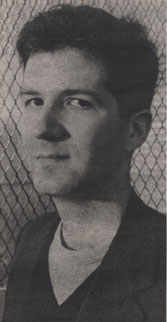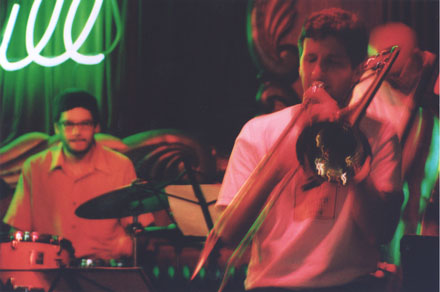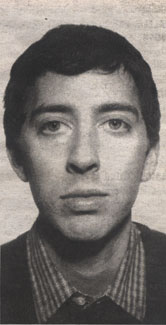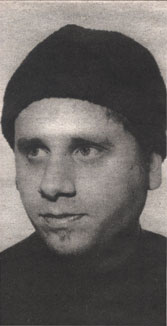|
THE
CHICAGO IMPROVISERS GROUP
 Everybody
knows that New York City rules when it comes to just about everything.
When it comes to jazz, Chicago may still be The Second City, but
it's number two with a bullet. You can see some serious inside
or outside jazz almost every night of the week, year round, and
the outside stuff is especially nurtured here; back in the Sixties,
the AACM planted major seeds that are still growing. In this environment,
I’ve been seeing a lot of live jazz, some good, some great, some
mediocre...but one of the most exciting groups I’ve seen yet is
the Chicago Improvisers Group. Everybody
knows that New York City rules when it comes to just about everything.
When it comes to jazz, Chicago may still be The Second City, but
it's number two with a bullet. You can see some serious inside
or outside jazz almost every night of the week, year round, and
the outside stuff is especially nurtured here; back in the Sixties,
the AACM planted major seeds that are still growing. In this environment,
I’ve been seeing a lot of live jazz, some good, some great, some
mediocre...but one of the most exciting groups I’ve seen yet is
the Chicago Improvisers Group.
Founder/organizer/trombonist
Jeb Bishop doesn’t necessarily agree. "There have been some live
recordings, but nothing is in the works for release. I don't know
whether I can say that I think the group has really found a particular
voice or vocabulary that needs to be added to the available glut
of recordings of improvised music."
I, for one, think this
group could make a great record, even as I agree with the part
about the glut. Free jazz and improvised music does seem to be
at a standstill. Like George W. Bush, players are increasingly
reliant on simple answers and easy juxtapositions. In American
politics its good vs. evil, and in improvised music it's soft
vs. loud or slow vs. fast. Or, what I think of as the Ellington
vs. Stockhausen dichotomy, where players either whip out smooth,
bluesy runs in order to ‘give a nod to tradition,’ or they play
noise in order to ‘break from tradition,’ seemingly unable to
create a synthesis from the two approaches. This kind of patterning
is what leads to the glut.
The CIG, on the other
hand, is creating a model for large-group long-form improvised
music that tramples all over the glut. Sure, all of the old signposts
-- soft, loud, slow, fast, Ellington, Stockhausen -- are in there,
but they're thrown into a blender with a lot of different speeds
and settings. Instead of just mapping out two poles and calling
it good, they go for the whole globe. Bishop admits "Sometimes
I am very pleased with the concerts." So am I, Jeb...so am
I....
Said concerts happen at the
Green Mill, a very charming dive bar in Chicago's Uptown neighborhood.
The Mill is said to be an old Al Capone hangout. So were approximately
300 other bars or restaurants in the greater Chicagoland area,
but the Green Mill actually still feels like it could've been.
In fact, the story goes that Capone ran it as a speakeasy during
Prohibition. Nowadays it's pretty quiet, especially during the
day, as Uptown's plentiful population of bums shuffle by, and
occasionally in. On one Sunday afternoon every month, the Chicago
Improvisers Group, usually seven or eight players strong, meets
at the Mill and performs two sets of their expansive music.
Jeb
Bishop: "We've only done it at the Mill. I'm not opposed
to doing it elsewhere, but it is kind of thought of as specific
to that locale. There's something special about playing in that
space on a Sunday afternoon. I'm sure it would affect the music
to take it elsewhere, not necessarily in a negative way. I got
the idea of doing it there and then from the fact that several
years ago Rob Mazurek used to do an early version of the Chicago
Underground Orchestra there every Sunday afternoon, but until
we started doing the CIG in Dec. 1999 no one had been using that
slot regularly for a while."
There
is indeed something special about a Sunday afternoon at the Green
Mill. Not only is the decor of the stage area something to see,
but as Kevin Whitehead put it in a Chicago Reader Critic's Choice
for the February CIG performance, "the Green Mill is never
lovelier than on a bright afternoon, when sunshine reflected off
passing cars makes light dance around the room." There is
no doubt that the Sunday afternoon lighting and ambience adds
a lot to the music...although the music adds quite a bit to the
lighting as well.

The sets consist of two or three long pieces, each one spontaneously
begun and spontaneously finished, usually on a dime. These beginnings
and endings, which almost never involve the entire group, alone
set the CIG well apart from the pack. In Derek Bailey's book Improvisation,
Gavin Bryars described group improvisations like this: "...pieces
always started tentatively, something big in the middle, and then
finished quietly. That sort of arc happened every time."
The CIG takes this arc apart and turns it into a tangled bundle
of shivering wire. Their form is a constantly shifting field that
uses the wide variety of players as a pool from which to spontaneously
select different duos, trios, quartets, and etcetera. Sometimes
a duo will play very loudly; sometimes the entire group will play,
but very softly. These various groupings are constantly changing
and segueing in and out of each other, according to how and when
musicians within the group choose to stop playing. There is a
certain stance the players have when they are not playing: standing
or sitting still, usually facing the audience, and listening hard.
They are ready for action at a moment's notice, but often choose
to stay silent for impressively long amounts of time, so that
unique combinations of voices can do their thing.
Jeb
Bishop: "The music is completely improvised; nothing
is mapped out in advance. That's why the group was started, in
order to try to do completely free improvisation with a larger
number of people than is usually the case. For that to be successful
(when it is) requires careful listening and a determination only
to make contributions that really add something to the whole.
Those are important qualities in all improvising, but as the group
gets larger they take on almost qualitatively different forms.
Put plainly, if everyone's playing at once it's hard to hear what's
going on. And it is important to try to exploit the expanded possibilities
for a wide range of colors and textures that are inherent in a
larger group. You can make formal changes in the music, creating
compositional form spontaneously, while improvising, and one good
way to do that is to let the instrumentation change from one combination
of players to a different one. I guess that those are skills that
we have all developed in our own ways, and of course we've all
played together in various different bands, some of us quite a
lot."
The line-up is usually
somewhat different each time, but there is a core group of regulars.
Bishop on trombone and Jim Baker on grand piano and analog synthesizer
strike me as the axis of the group, around which all the other
players revolve. They are the only two musicians who have been
present at all three CIG performances I've seen, and they even
stand on opposite ends of the stage. Bishop gets all kinds of
music out of the trombone, between pure melody and pure strangeness.
When he is using a mute and Baker is on his synthesizer, it can
be hard to tell who is making which sounds. Baker is well-respected
in Chicago but really deserves a higher profile in the jazz world.
Not only is his piano playing sweeping, expansive, and classically
beautiful, he has the ace-in-the-hole of being a mysterious master
of analog electronics. Watching Baker play synth is one of the
highlights of a CIG performance. He stands at an open suitcase
of equipment, mysteriously lit from within like the briefcase
in Pulp Fiction. Illuminated by this light like a Dr. Frankenstein,
with patch chords hanging around his neck, he coaxes squelches
and buzzes with rather jarring body movements. This strange insectoid
music is subtle, and often drowned out by wailing horns, but when
it emerges through the cracks in the ensemble it is almost always
a perfect futuristic accompaniment. (I recall an all-too-brief
duet between Baker on synth and drummer Tim Daisy as being an
all-time CIG highlight.)
In and around
the Bishop/Baker axis orbit many different styles, with players
old and new. Dave Rempis falls in the latter category; he's a
member of the Vandermark 5 but I've only seen him with the CIG.
He's very good at fast, subtle runs on both tenor and alto sax.
It seems like whenever I hear a surprising new sound and find
myself looking from player to player, trying to locate the source,
it ends up coming from Rempis.
Fred Lonberg-Holm
has been on cello and electric mandolin for the last two CIG shows.
After seeing a rather overly dry performance by his group Pillow,
I wondered if perhaps he was a bit overrated, but seeing him in
the CIG makes me understand why he’s in demand. He’s a wild card,
a seemingly loose player, adept at classically modal music but
also the group’s main source for pure noise. He uses the cello
in many extended ways, sawing below the bridge, preparing it with
various gewgaws...it even has an ‘extra string’ that can create
quite a racket. I won’t even go into his electric mandolin playing,
except to say that it is often surprisingly melodic and even more
often creates a sound like primitive bubbling electronics.
Todd Margasak on cornet
is another player who seems destined to be underrated, with a
style that sidesteps the Ellington-or-Stockhausen trap by being
supple, calm, and unabashedly melodic (though he can get surprisingly
noisy). I can't think of any other groups Margasak has played
in, but he's just plain good. On bass, I've seen Kent Kessler
play two concerts and Jason Roebke one. Roebke is young and good
but Kessler is more striking in many ways, from his diverse and
physical playing to his bald head (covered by a cowboy hat between
sets), Clark Kent glasses, and spaghetti western cheroot. Tim
Daisy played drums at the first concert; the second concert was
without a drummer. Daisy, who is also in the Vandermark 5, seems
like he's about 17 years old but the kid has got mad skills and
is completely clued in to the CIG's technique of making improvised
music sound totally assured and planned. Never would he play improv
music's "searching" cliches...drummers are often most
guilty of this by relying too much on 'atmospheric' cymbal washes,
but Daisy would leave and then re-enter the fray with big, assured
rhythms that sounded like they were played on cue rather than
instinct.
Ken Vandermark plays
with the group when he's not on the road. The February concert
also featured Aram Shelton, another kid who looks about 17 years
old and is quite skilled, on alto sax and clarinet, and there
was also room for Mark Unternaehrer, a tuba player visiting from
Switzerland.
Jeb
Bishop: "The lineup changes according to who's available,
but there is a certain core pool that I think of it as drawing
from. I try to keep that at least somewhat stable, at least for
now, because at the moment what interests me is the idea of the
same group meeting somewhat regularly and building on something
that came before, rather than dealing with a new situation in
terms of newcomers or unfamiliar players."
 
I asked Bishop if there were any CIG plans or objectives that
this interview hadn't touched on, and he responded with some,
as well as with a little history.
Jeb
Bishop: "It really started at first because the European
drummer Paul Lytton was in town for a project, and he was asking
whether a large improvising group exists here, and sort of encouraging
Ken and me to try to put one together. Lytton has been involved
with an influential large European free-improvising band called
the King Übü Orchestra. I had the idea of trying to
do it at the Green Mill, partly because they have a really nice
piano there for Jim Baker to play, and eventually I was able to
persuade the Mill to let us try it, for which I would like to
take this opportunity to thank them. Ken and I discussed possible
personnel and I made the necessary phone calls, etc. At first
we were a bit leery of just jumping into total improvisation with
such a large band -- the first gigs had 11 or so people in the
group -- so Ken and I brought in 'compositions' that were intended
as sketches to organize improvising, sort of like bridges between
playing compositions and completely improvising. One problem with
that is that (in my opinion), no matter how tenuous the instructions
on the page, there is still a clear gap between the experience
of playing with a chart of some kind and doing completely free
improvising. If you have a sheet in front of you you are always
directed towards that sheet, everything you do relates to that
somehow -- you're always thinking, somewhere in your mind, about
'where you are in the piece' and 'is the end coming up, what do
I do next,' etc. And you think about things like that when you're
just improvising, too, but really in a different way. So I don't
know if the intended 'bridge' can really be built; it's more like
you create this structure on one side of the gap that might take
you somewhere, but it doesn't get you very far across the gap.
Anyway, nobody was entirely happy with that situation, and we
quit using the charts fairly early on. Since that time I've been
the one doing the organizing for the project, but that really
involves only getting the people together at the Mill at the prescribed
time. We did at one point have a couple of rehearsals in which
we tried to deal with approaches to the problems of improvising
with a large band. That hasn't happened in a while, partly because
my own tendency is away from the direction of even suggesting
guiding ideas in a situation like that. The price to pay for that
may be that sometimes there is a lack of focus or absence of a
clear 'voice'; but in my view if such a voice doesn't arise organically
from the naturally shared (or naturally conflicting) concerns
and interests of the players involved there's no point in trying
to impose one, or you can't impose one without moving in the direction
of composition. Not that there's anything wrong with that, but
it is not what the CIG does, at present."
As of this
writing, the next Chicago Improvisers Group matinee will be Sunday,
May 12, 2PM at the Green Mill, 4802 N. Broadway, Chicago.
|

